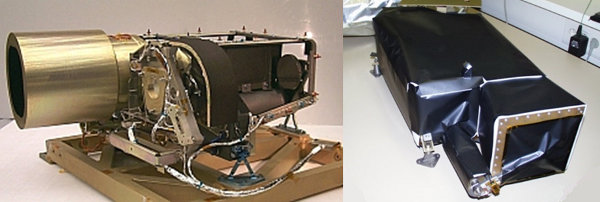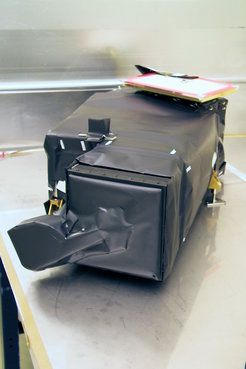
OSIRIS: Optical, Spectroscopic, and Infrared Remote Imaging System
OSIRIS is the scientific imaging system on the orbiter of ESA's Rosetta mission to comet 67P/Churyumov-Gerasimenko.
OSIRIS comprises two cameras: a high resolution Narrow Angle Camera (NAC) and a Wide Angle Camera (WAC). OSIRIS observes the cometary rotation, and studies the physical and chemical processes that occur in, on, and near the cometary nucleus.
The strength of OSIRIS is the coverage of the entire nucleus and its local environment with high spatial and temporal resolution. The spectral sensitivity entends the reflected solar continuum from the near-UV up to the onset of thermal emission.
After the launch of Rosetta on 2nd March 2004, OSIRIS was activated on several occasions before the arrival to the main target, comet 67P/Churyumov-Gerasimenko. It performed several important scientific observations en route to the comet:
- A monitoring campaign of comet 9P/Tempel 1 around the Deep Impact event on 4 July 2005
- A swing-by manoeuvre at Mars on 26 February 2007
- The fly-by of asteroid 2867 Steins on 5 September 2008
- Two Earth swing-bys in Nov. 2007 and Nov. 2009
- The observation of the remnant of a collision between two main-belt asteroids in February 2010 -
- The fly-by of asteroid 21 Lutetia on 10 July 2010
- Early observation of the comet from more than 1au distance in March 2011.
Rosetta arrived at comet 67P on 6 August 2014. The spacecraft stayed at the comet for more that 2 years to study the surface and its physical processes in detail. It observed the wake-up of the comet approaching the Sun, the peak of activity at perihelion in August 2015, and the comet's retreat back into the outer Solar System. The landing of the entire spacecraft on the surface on the comet concluded the mission on 30 September 2016 near deep pits on the small lobe of 67P. OSIRIS delivered a total of about 100.000 images over the course of the Rosetta mission.

Outburst on comet 67P in August 2015
The OSIRIS cameras were provided by a consortium of 9 institutes from 5 European countries and ESA under the leadership of the the Max-Planck-Institute for Solar System Research (MPS) (Principal Investigator: Holger Sierks). The participating institutes of the consortium are: MPS (Göttingen, Germany), LAM (Marseille, France), UPD (Padova, Italy), IAA (Granada, Spain), University of Uppsala (Sweden), ESTEC (ESA, Noordwijk, The Netherlands), UPM (Madrid, Spain), INTA (Madrid, Spain), IDA (Braunschweig, Germany).
Science Objectives:
The main objective of OSIRIS is the study of the physical and chemical processes that occur in, on, and near the cometary nucleus. In particular, OSIRIS allows the determination of the outflow of gas and dust from different regions of the cometary nucleus, and the comparison of active areas with deviations in surface composition, in topography, and in local insolation. The main science objectives of OSIRIS are:
- characterise the size, shape, and density of the nucleus of comet 67P/Churyumov-Gerasimenko
- determine the rotational properties of the comet
- monitor the nucleus activity and evolution
- study the chemical composition of the nucleus surface
The Instrument in detail:
OSIRIS consists of two cameras: a high resolution Narrow Angle Camera (NAC) and a Wide Angle Camera (WAC). Both are unobstructed off-axis mirror systems, equipped with two filter wheels containing 8 positions each, and with backside illuminated CCD detectors comprising 2048 x 2048 pixels with a pixel size of 13.5 µm.

NAC (Narrow Angle Camera)
The NAC is designed to obtain high resolution images of the surface of comet 67P/Churyumov-Gerasimenko at distances from more than 500 000 km down to 1 km (resulting in a resolution of ~2 cm per pixel). The camera detects small ejected dust particles close to the cometary nucleus (brightness ratio = 1/1000). The 12 filters of the NAC characterise the nucleus surface over a spectral range from 250 to 1000 nm. The NAC has a square field of view (FOV) of 2.2 degrees with an instantaneous field of view (IFOV) of 18.6 µ rad (3.8 arcsec) per pixel, and a focal ratio of f/8. The camera is an anastigmat with three mirrors, it has a focal length of 717 mm. The NAC has a mass of 13.2 kg.

WAC (Wide Angle Camera)
The WAC is optimized for the near nucleus environment. The main objective of the WAC is the study of the dust coma and the gas emissions as function of position and viewing angle close to the nucleus. The WAC is equipped with 14 filters in the wavelength range from 240 to 720 nm. Seven narrow band filters isolate gas emissions from the cometary coma; reference filters measure the dust continuum at wavelengths close to the gas emission lines. The WAC has a FOV of 12x12 degrees with an angular resolution of 101 µ rad (20.5 arcsec) per pixel, and a focal ratio of f/5.6. The camera is an anastigmat with two aspherical mirrors, it has a 140 (sag)/131 (tan) mm focal length. The WAC weighs 9.5 kg.

Basic parameters of the NAC and WAC systems
| NAC | WAC | |
| Optical design | 3-mirror off-axis | 2-mirror off-axis |
| Angular resolution [μrad px-1] | 18.6 | 101 |
| Focal length [mm] | 717.4 | 140 (sag)/131 (tan) |
| Mass [kg] | 13.2 | 9.48 |
| Field of view [°] | 2.20 - 2.22 | 11.35 - 12.11 |
| F-number | 8 | 5.6 |
| Spatial scale from 100 km [m px-1] | 1.86 | 10.1 |
| Typical filter bandpass [nm] | 40 | 5 |
| Wavelength range [nm] | 250 - 1000 | 240 - 720 |
| Number of filters | 12 | 14 |



